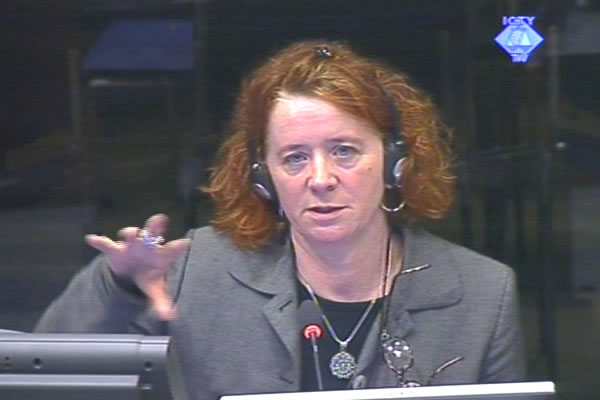Home
HORRIFIC SCENES FROM SREBRENICA
German nurse Christine Schmitz testified at the trial of Radovan Karadzic about ‘horrific’ scenes she saw in Srebrenica after the enclave fell: the shelling, the exodus of the population to the UN base in Potocari, their fear and uncertainty, the separation of men from women and children, and single shots she heard from the direction of the house where the men were taken
 Christine Schmitz, witness at the Radovan Karadzic trial
Christine Schmitz, witness at the Radovan Karadzic trial The trial of former Republika Srpska president Radovan Karadzic for genocide and other crimes in BH continued with the evidence of Christine Schmitz, a German nurse who worked for the humanitarian organization Doctors without Borders in the Srebrenica hospital when the enclave fell in July 1995.
According to the summary of the witness’s written statement, Schmitz arrived in Srebrenica on 24 June 1995. She witnessed the shelling of Srebrenica, the exodus of the people to the UN base in Potocari, the separation of the men from the rest of the population, and the deportation of women and children to the territory controlled by the BH Army. She also saw the Serb soldiers taking captured men to the Srebrenica execution sites. The witness heard single shots near the house where the men were held and from the nearby woods. The witness left the enclave on 21 July 1995 together with other staff working for Doctors without Borders. Most of the local staff also left with them, after they were granted amnesty by Karadzic.
As she sat in court, remembering the people who had to spend the night in the open on 12 July 1995 near the UN base in Potocari, the witness cried. It was terrible, she said. People were hungry, thirsty, ‘petrified’, the witness recounted. Children didn’t play; they just lay on the ground. The witness sent a telegram that night to the Doctors Without Borders headquarters in Belgrade, saying that she could no longer bear it, and asked for a replacement. ‘I thought I would break down and wouldn’t be able to keep on working’, the witness explained to the judges. Schmitz said that she soon realized no one would come so she pulled herself together and went on doing her job.
In the cross-examination, Karadzic tried to explain away the single shots the witness had heard as Serb soldiers ‘messing around’ and celebrating the victory by ‘firing into the air’. Asked why she feared for the lives of the local staff working for the Doctors Without Borders, the witness said that at that point she was more disposed to believe her local staff and their fears that they would be killed, than UNPROFOR soldiers who were trying to reassure them.
Karadzic repeated yet again his argument: there was no famine in Srebrenica and the people left the enclave voluntarily. Karadzic argued that on the eve of the operation, the Serb side allowed a convoy with food, fuel and other necessities to enter the enclave. The convoy was purportedly to arrive in the town on 11 July 1995. This showed, in Karadzic’s view, that the Serb army never intended to enter the town. The witness didn’t remember that a convoy was supposed to arrive on 11 July 1995. What she knew was that a convoy arrived in the evening of 13 July 1995, after the people had already been forcibly deported from Srebrenica. It was her impression that the people had left the enclave under duress.
After Christine Schmitz completed her evidence, the trial of Radovan Karadzic continued in closed session with the testimony of protected witness KDZ 391.
Linked Reports
- Case : Karadzic
- 2012-03-23 KARADZIC AND ‘TALL TALES’ FROM SREBRENICA
- 2012-03-22 KARADZIC’S ‘NEW INFORMATION’ ON THE NUMBER OF SREBRENICA VICTIMS
- 2012-03-21 UPDATED INFORMATION ON IDENTIFIED SREBRENICA VICTIMS
- 2012-03-27 UPDATED INFORMATION ABOUT SREBRENICA MASS GRAVES
- 2012-03-28 WITNESS: THERE WAS NO CLEAN-UP
- 2012-03-29 REIGN OF FEAR IN ZVORNIK
